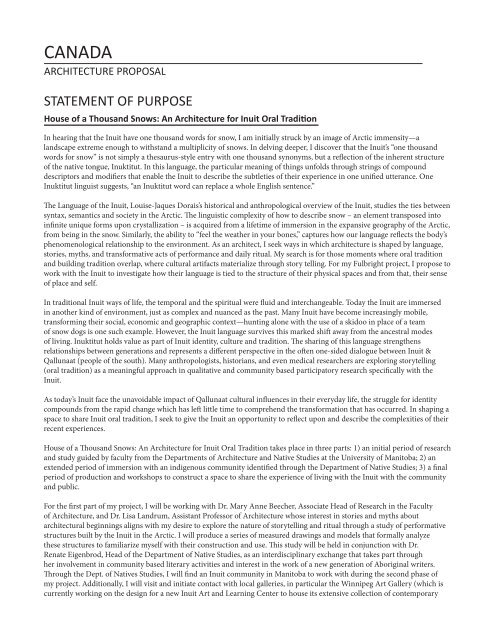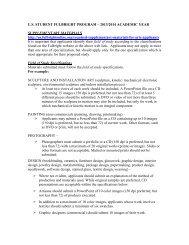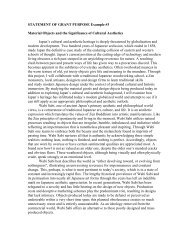STATEMENT OF PURPOSE - risd/careers
STATEMENT OF PURPOSE - risd/careers
STATEMENT OF PURPOSE - risd/careers
Create successful ePaper yourself
Turn your PDF publications into a flip-book with our unique Google optimized e-Paper software.
CANADA<br />
ARCHITECTURE PROPOSAL<br />
<strong>STATEMENT</strong> <strong>OF</strong> <strong>PURPOSE</strong><br />
House of a Thousand Snows: An Architecture for Inuit Oral Tradition<br />
In hearing that the Inuit have one thousand words for snow, I am initially struck by an image of Arctic immensity—a<br />
landscape extreme enough to withstand a multiplicity of snows. In delving deeper, I discover that the Inuit’s “one thousand<br />
words for snow” is not simply a thesaurus-style entry with one thousand synonyms, but a reflection of the inherent structure<br />
of the native tongue, Inuktitut. In this language, the particular meaning of things unfolds through strings of compound<br />
descriptors and modifiers that enable the Inuit to describe the subtleties of their experience in one unified utterance. One<br />
Inuktitut linguist suggests, “an Inuktitut word can replace a whole English sentence.”<br />
The Language of the Inuit, Louise-Jaques Dorais’s historical and anthropological overview of the Inuit, studies the ties between<br />
syntax, semantics and society in the Arctic. The linguistic complexity of how to describe snow – an element transposed into<br />
infinite unique forms upon crystallization – is acquired from a lifetime of immersion in the expansive geography of the Arctic,<br />
from being in the snow. Similarly, the ability to “feel the weather in your bones,” captures how our language reflects the body’s<br />
phenomenological relationship to the environment. As an architect, I seek ways in which architecture is shaped by language,<br />
stories, myths, and transformative acts of performance and daily ritual. My search is for those moments where oral tradition<br />
and building tradition overlap, where cultural artifacts materialize through story telling. For my Fulbright project, I propose to<br />
work with the Inuit to investigate how their language is tied to the structure of their physical spaces and from that, their sense<br />
of place and self.<br />
In traditional Inuit ways of life, the temporal and the spiritual were fluid and interchangeable. Today the Inuit are immersed<br />
in another kind of environment, just as complex and nuanced as the past. Many Inuit have become increasingly mobile,<br />
transforming their social, economic and geographic context—hunting alone with the use of a skidoo in place of a team<br />
of snow dogs is one such example. However, the Inuit language survives this marked shift away from the ancestral modes<br />
of living. Inuktitut holds value as part of Inuit identity, culture and tradition. The sharing of this language strengthens<br />
relationships between generations and represents a different perspective in the often one-sided dialogue between Inuit &<br />
Qallunaat (people of the south). Many anthropologists, historians, and even medical researchers are exploring storytelling<br />
(oral tradition) as a meaningful approach in qualitative and community based participatory research specifically with the<br />
Inuit.<br />
As today’s Inuit face the unavoidable impact of Qallunaat cultural influences in their everyday life, the struggle for identity<br />
compounds from the rapid change which has left little time to comprehend the transformation that has occurred. In shaping a<br />
space to share Inuit oral tradition, I seek to give the Inuit an opportunity to reflect upon and describe the complexities of their<br />
recent experiences.<br />
House of a Thousand Snows: An Architecture for Inuit Oral Tradition takes place in three parts: 1) an initial period of research<br />
and study guided by faculty from the Departments of Architecture and Native Studies at the University of Manitoba; 2) an<br />
extended period of immersion with an indigenous community identified through the Department of Native Studies; 3) a final<br />
period of production and workshops to construct a space to share the experience of living with the Inuit with the community<br />
and public.<br />
For the first part of my project, I will be working with Dr. Mary Anne Beecher, Associate Head of Research in the Faculty<br />
of Architecture, and Dr. Lisa Landrum, Assistant Professor of Architecture whose interest in stories and myths about<br />
architectural beginnings aligns with my desire to explore the nature of storytelling and ritual through a study of performative<br />
structures built by the Inuit in the Arctic. I will produce a series of measured drawings and models that formally analyze<br />
these structures to familiarize myself with their construction and use. This study will be held in conjunction with Dr.<br />
Renate Eigenbrod, Head of the Department of Native Studies, as an interdisciplinary exchange that takes part through<br />
her involvement in community based literary activities and interest in the work of a new generation of Aboriginal writers.<br />
Through the Dept. of Natives Studies, I will find an Inuit community in Manitoba to work with during the second phase of<br />
my project. Additionally, I will visit and initiate contact with local galleries, in particular the Winnipeg Art Gallery (which is<br />
currently working on the design for a new Inuit Art and Learning Center to house its extensive collection of contemporary
Inuit art) and Plug-In Gallery (which offers an international post-graduate artist residency for their Summer Institute), for<br />
potential future exhibition of the work and/or opportunities to hold workshops in their gallery space.<br />
For the second part of my project, I will live in and engage with an Inuit community (tbd through Dept. of Native Studies)<br />
living in northern reaches of Manitoba. Learning some Inuktitut, and limiting my use of the widely spread tongue of English,<br />
my aim is to capture Inuit sensibility and sensitivity through observation and participation. Sharing the languages of the arts,<br />
we will draw, photograph, build, and film together. The changing nature of Inuit life will be documented and constructed<br />
into a narrative that shares the experience and the language, Inuktitut, as tied to representations of their inhabited spaces. An<br />
image of the Inuit, one that reflects their understanding of their place and self, will emerge. In asking how the Inuit converse, I<br />
am seeking a dialogue: an exchange between my culture and theirs.<br />
After this period of immersion in the Inuit community, I will return to University of Manitoba for the final phase of the<br />
project: to work collaboratively with the faculty and students to create structures to house these documented stories. I am<br />
particularly interested in working with indigenous young adults to explore architecture as a way of constructing place and<br />
identity. The project will use built structures and the structure of film as physical mediums in which we overlay language and<br />
experience to construct narrative. Through a series of workshops we will re-imagine how oral tradition and myth continue to<br />
transform space and demonstrate that through storytelling we can create architecture: a House of A Thousand Snows.<br />
Today, our existential and experiential relationship with the environment is further understood through interconnectedness—<br />
interactions transformed through multiple dynamic interfaces. This alters the very nature of how we act and how we speak.<br />
Not unlike the Inuit, we are searching for words that accurately describe our experiences, words that give depth and structure<br />
to our lives. The reflective relationship of language to the inhabitation of space is important in understanding how shifts in<br />
environment not only affect indigenous ways of life, but how we address the complexities of these changes in the everyday<br />
practice of our lives.
















